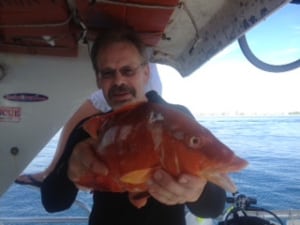Snapper (Pargo) Fishing in Costa Rica: A Delicious and Powerful Inshore Challenge
Costa Rica is home to a diverse variety of snapper species, known locally as “pargo”, offering exciting inshore fishing and top-tier table fare. These prized game fish are often found in rocky structures, reefs, ledges, caves, and around underwater drop-offs where they lie in wait to ambush prey. Snapper are voracious feeders, targeting crustaceans like crabs and shrimp, as well as squid, octopus, and smaller fish.
For anglers who appreciate a tough fight and a fantastic meal, snapper fishing in Costa Rica delivers on every level.

Top Snapper Species in Costa Rica
Costa Rica’s Pacific waters are home to a wide range of snapper species, each with its own behavior, habitat preferences, and culinary value. Here’s a breakdown of the most commonly targeted and caught types:
🐟 Cubera Snapper (Pacific Dog Snapper) – The King of the Reef
The Cubera Snapper (Lutjanus cyanopterus) is the largest and most coveted of all snappers in Costa Rica. Often referred to as the “king of the reef”, these fish can grow over 100 pounds, though most catches range between 30 and 60 pounds. Cuberas are long-lived (up to 60 years) and cautious predators, making them a challenging and rewarding target.
-
Habitat: Found in depths from 15 to over 200 feet, often hiding in rocky caves or ledges.
-
Tactics: Live bait such as small tunas, crabs, or lobsters work well. Heavy tackle is essential, as cubera will immediately dive back into structure when hooked.
-
Fight Style: Incredibly strong and smart fighters. If not stopped quickly, they’ll break you off on rocks and coral.
Bucket List Achievement: Catching a Cubera on a surface popper is considered a pinnacle moment in inshore fishing.
🐟 Mullet Snapper (Pargo Lisa)
The Mullet Snapper is a slender species that often forms large, aggressive surface-feeding schools. They can be seen boiling baitfish near the surface, offering excellent sight-casting opportunities.
-
Size: Typically 10–25 pounds.
-
Bait & Lures: Readily hit poppers and live bait. Great sport on medium spinning gear.
-
Meat Quality: Tasty, but be sure to remove the dark red bloodline, which can have a bitter flavor.
🐟 Pacific Red Snapper
The term “Pacific Red Snapper” often refers to a group of similar-looking species, including:
-
Colorado Snapper
-
Silk Snapper
-
Rosy Snapper
These fish typically average 15–25 pounds and are prized for their firm, white, flavorful meat. They are found along rocky ledges and reefs, usually at depths of 50–200 feet.
🐟 Yellow Snapper (Pargo Amarillo)
The Yellow Snapper is easily identified by its bright yellow tail and fins, and reddish-brown body.
-
Habitat: Prefers shallow rocky reefs and drop-offs.
-
Size: Usually under 10 pounds.
-
Behavior: Schooling fish often found mixed with other snapper species.
-
Taste: Excellent table fare.
🐟 Rock Snapper (Green-Striped Snapper)
This distinctively colored snapper has an olive-green body with alternating dark and light vertical stripes, giving it a camouflage appearance.
-
Habitat: Inhabits bedrock and reef structures with lots of holes and hideouts.
-
Behavior: Darts into structure immediately when hooked—quick pressure is critical.
-
Size: Commonly 3–15 pounds.
-
Meat Quality: High—delicious when grilled or fried.
🐟 Spotted Rosy Snapper (Red Snapper / Pargo Rosado)
Often misidentified in restaurants as “red snapper,” this smaller species has a pink to red coloration with subtle spotting.
-
Size: Typically 1–4 pounds, with a few reaching 5–6 pounds.
-
Habitat: Found between 50 to 150 feet over rocky bottoms, often in large schools.
-
Taste: One of the best-eating fish in Costa Rica, especially when whole-fried.
-
Fun Fact: These are commonly caught while bait fishing for other species like blue runners.
Snapper Fishing Techniques in Costa Rica
Snapper are ambush predators, so successful fishing requires a strategic approach:
🎣 Live Bait
-
Use crabs, small lobsters, sardines, or small tunas.
-
Drop near reef edges, rocky points, or ledges.
🎣 Dead Bait
-
Dead baits like cut bonito or squid are highly effective, especially when drifted over deeper reefs.
🎣 Artificial Lures
-
Topwater poppers work near rocky outcroppings during early morning and late afternoon.
-
Jigs and soft plastics are excellent for vertical fishing near structure.
🧰 Tackle Tips
-
Use heavy-duty rods and reels with 40–80 lb braided line.
-
Fluorocarbon leaders can help with cautious fish.
-
Be ready to apply heavy drag immediately to keep snapper out of cover.
Best Time for Snapper Fishing in Costa Rica
Snapper fishing is productive year-round, but tends to be most consistent during the green season (May to October) when baitfish are more abundant and reefs are active. However, the dry season also produces excellent results, especially inshore near mangroves and coastal reef lines.
Final Thoughts
Whether you’re targeting monster Cubera Snapper on live bait or throwing poppers at boiling schools of Pargo Lisa, snapper fishing in Costa Rica delivers adrenaline-pumping action and unmatched culinary rewards. With expert local guides, thriving marine habitats, and an abundance of species, this inshore experience is a must for any visiting angler.
Plan your trip, book your charter, and discover the thrill of hooking into one of Costa Rica’s most prized reef dwellers—the mighty pargo.
